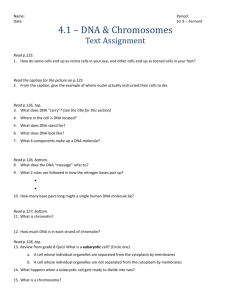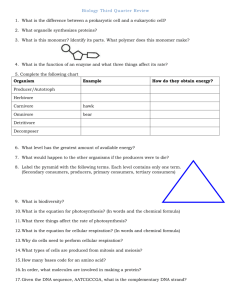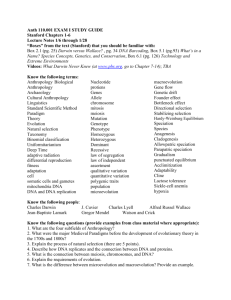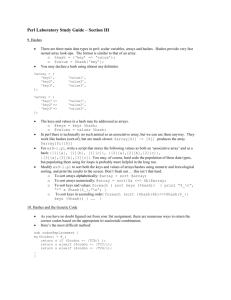Final Exam Study Guide
advertisement
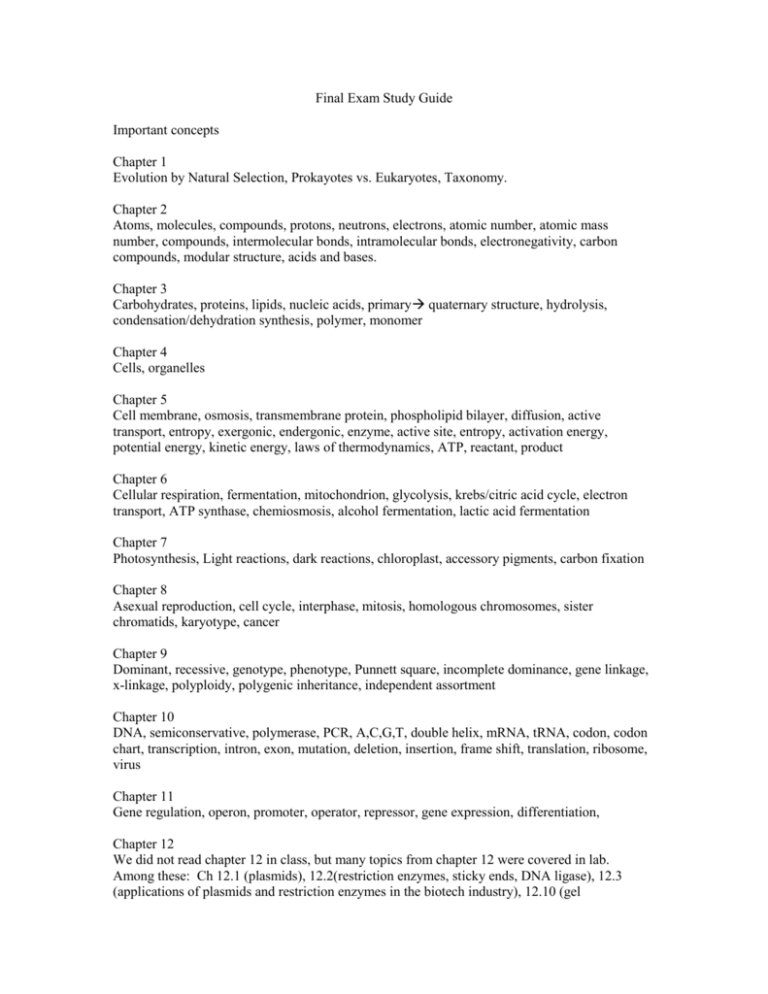
Final Exam Study Guide Important concepts Chapter 1 Evolution by Natural Selection, Prokayotes vs. Eukaryotes, Taxonomy. Chapter 2 Atoms, molecules, compounds, protons, neutrons, electrons, atomic number, atomic mass number, compounds, intermolecular bonds, intramolecular bonds, electronegativity, carbon compounds, modular structure, acids and bases. Chapter 3 Carbohydrates, proteins, lipids, nucleic acids, primary quaternary structure, hydrolysis, condensation/dehydration synthesis, polymer, monomer Chapter 4 Cells, organelles Chapter 5 Cell membrane, osmosis, transmembrane protein, phospholipid bilayer, diffusion, active transport, entropy, exergonic, endergonic, enzyme, active site, entropy, activation energy, potential energy, kinetic energy, laws of thermodynamics, ATP, reactant, product Chapter 6 Cellular respiration, fermentation, mitochondrion, glycolysis, krebs/citric acid cycle, electron transport, ATP synthase, chemiosmosis, alcohol fermentation, lactic acid fermentation Chapter 7 Photosynthesis, Light reactions, dark reactions, chloroplast, accessory pigments, carbon fixation Chapter 8 Asexual reproduction, cell cycle, interphase, mitosis, homologous chromosomes, sister chromatids, karyotype, cancer Chapter 9 Dominant, recessive, genotype, phenotype, Punnett square, incomplete dominance, gene linkage, x-linkage, polyploidy, polygenic inheritance, independent assortment Chapter 10 DNA, semiconservative, polymerase, PCR, A,C,G,T, double helix, mRNA, tRNA, codon, codon chart, transcription, intron, exon, mutation, deletion, insertion, frame shift, translation, ribosome, virus Chapter 11 Gene regulation, operon, promoter, operator, repressor, gene expression, differentiation, Chapter 12 We did not read chapter 12 in class, but many topics from chapter 12 were covered in lab. Among these: Ch 12.1 (plasmids), 12.2(restriction enzymes, sticky ends, DNA ligase), 12.3 (applications of plasmids and restriction enzymes in the biotech industry), 12.10 (gel electrophoresis), 12.14 (PCR) Some of these technologies are to be considered NEW material (not part of the comprehensive review!) so make sure you study them! Chapter 13 Charles Darwin, Evolution, Natural selection, Evidence for evolution, sexual selection, genetic drift, adaptive radiation, Hardy-Weinberg Equilibrium, mutation, directional/stabilizing/disruptive selection Chapter 14 Species, speciation, reproductive barriers, reproductive isolation Things that you should DEFINITELY expect on the exam: -A question related to the GE lab of the final 3 weeks of lab -Half the exam to be about Chapters 15(geologic time, radiometric dating, classification), 16, 23(blood), 24 (immunology), and 28(neurons and the nervous system) *Note- these chapters are not thoroughly discussed in this study guide. You have study guides for those chapters. Definitely spend about half your study time Things you should consider for the exam -All the kinds of biological macromolecules, their uses, and how they are synthesized. -I could label a eukaryotic cell with organelles, and describe the function of those organelles. -I can describe a reaction as endergonic or exergonic, and explain the role of ATP and enzymes in the energetics of cells -I can break respiration into three basic parts, and could explain each part in a few sentences of general information. -I can break photosynthesis into two parts. I can discuss the relationship between respiration and photosynthesis in terms of reactants and products. -I can discuss cancer in terms of the cell cycle. -I can compare and contrast mitosis and meiosis in terms of their objectives, and the cellular results of the processes. I know the differences between homologous chromosomes and sister chromatids, and why those differences are important -I can relate homologous chromosomes to Mendelian inheritance and Punnett squares. I can do most Punnett squares as found in the textbook or in our lab problem set. -I am familiar with the structure of DNA and its function, and how that structure and function differs from RNA. I know different kinds of RNA and their roles. I can read a codon chart, explain how DNA is copied, and differentiate DNA replication from DNA expression. -I can identify types of mutations, and predict the consequences of different kinds of mutations. -I understand how viruses are different from normal cellular life. I can describe two basic viral life cycles, lytic and lysogenic. -I can describe how genes are expressed in prokaryotes. I know how eukaryotic cells differentiate one from another- that is, how we get muscle, skin and nerve cells from a single-celled zygote. -I can explain how natural selection drives the evolution of a population’s allele frequencies, and how such changes can result in major changes in the appearance of animals over millions of years of evolution. -I can think of examples of evidence used to support Darwin’s theory of evolution by natural selection. -I can define genetic drift, and explain how genetic drift can work to change a species along with natural selection. -I know forces that affect speciation, and how speciation can affect evolution.






